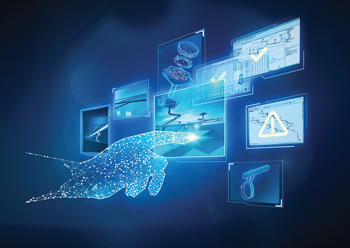Intelligence instead of number crunching
Geberit*, a European leader in the field of sanitary products, says its ProPlanner software uses artificial intelligence with reinforced learning for correctly calculating roof drainage solutions with Geberit Pluvia.
01 July 2021
Whereas fictional characters such as Gyro Gearloose’s Little Helper or Arnold Schwarzenegger as the Terminator used to wow us with their virtually unlimited artificial intelligence, AI has now become an integral part of everyday life. It is the term used in IT to describe the approach where machines can make intelligent decisions similar to those made by humans – the software learns and thus becomes intelligent.
“At the moment, artificial intelligence is split into two areas at Geberit – classic AI as seen in image or voice recognition, and reinforcement learning,” explains Pascal Schäfer, who is responsible for AI applications in the Customer Applications team at Geberit. “While classic AI needs humans to feed the computer with lots of examples, reinforcement learning sees the computer take over the learning process. Here, the AI follows the same principle as if I were a child learning a computer game – I continue to do what is good for me and avoid what is bad for me.”
Challenging roof drainage
 |
|
Schäfer … responsible for AI applications in Geberit’s Customer Applications team. |
Designing a siphonic roof drainage system such as Geberit Pluvia with the correct dimensions is surprisingly difficult. All pipe diameters have a mutual effect on one another. If the dimensioning is incorrect – with diameters that are too large or too small on individual sections – the siphonic effect of the Pluvia system no longer works. The water then collects on the roof, with unforeseeable consequences for both people and the building itself. Simply trying out all the variations on offer is not an option as there are countless different possibilities.
“Planning and dimensioning a Geberit Pluvia installation correctly requires a combination of intuition, hydraulic know-how and experience. Since the very beginning, we have supported sanitary engineers with heuristics in the Geberit ProPlanner planning software – or expertise in the form of code, to put it another way,” explains Schäfer.
With this approach, 76 per cent of all Pluvia installations can be dimensioned correctly and completely automatically. Every calculation – whether dimensioned by hand or automatically – is also checked using a test algorithm developed by the hydraulics specialists from Geberit. This either approves a calculation or rejects it.
Step by step with AI
Humans are very good at learning from examples. Sometimes, only a few examples are necessary before we can apply solutions to new situations. In classic AI, computers also attempt to learn from examples. However, to do this they often need thousands or even millions of examples. While they are thus much less efficient than humans, they have a huge amount of processing power at their disposal. Since 2017, ProPlanner has used machine learning whenever a solution cannot be achieved using heuristics, with the success rate improving to 93.4 per cent with this AI method alone.
“The success rate using AI is impressive. However, users have still been unable to dimension 6.6 per cent of the planned Pluvia installations using ProPlanner alone up to now. It is exactly these tricky projects that appeal to us in particular,” comments Schäfer. “With the addition of reinforcement learning – a type of AI where the computer learns the process autonomously and completely without examples – ProPlanner has further increased the success rate to over 99 per cent since 2018.”
The use of reinforcement learning is a hot topic in the field of research. Geberit is part of an exclusive circle of companies worldwide to already make productive use of this advanced form of AI. Geberit’s “Little Helper” has certainly done its job.
AI in ProPlanner
Machine learning is an AI approach in which the computer learns autonomously from examples. The most well-known method is based on a large amount of examples together with the possible “correct” answers. As a rule of thumb, the more examples the better the possible answers. Hundreds of thousands – if not millions – of examples are needed for machine learning. After the learning phase, the computer then attempts to provide the correct answer for new, unknown calculations and situations.
This type of machine learning is used for product recommendations on online shopping platforms, for example. Here, the software identifies which products a user prefers and then suggests similar ones. Image and voice recognition applications also use this method. In Geberit ProPlanner, the AI is taught using data from all Pluvia calculations. Based on what it has learned, the system then makes suggestions for dimensioning in new projects.
On the other hand, reinforcement learning (RL) is a type of machine learning where the computer learns complex processes – such as flying a helicopter or playing chess – autonomously. Examples with the “correct” answers are no longer required here. The algorithms learn by themselves by trying things out tactically. Reinforcement learning is similar to how children learn things. Without instructions, children quickly get to grips with complex computer games when they are rewarded for good gaming strategies. Successful strategies are pursued while unsuccessful ones are rejected. In Geberit ProPlanner, the computer learned a suitable Pluvia dimensioning strategy autonomously over a period of several weeks according to real, existing installations.
* The globally operating Geberit Group is headquartered in Rapperswil-Jona, Switzerland. Its production network encompasses 29 production facilities, of which six are located overseas. With around 12,000 employees in around 50 countries, Geberit generated sales of CHF3.0 billion ($3.27 billion) in 2020.
- Mertoğlu keen to spread cheer in region
- Intelligence instead of number crunching
- Renault delivers 10 trucks to Al Jadawel
- Systemair provides Eurovent summer label
- Liebherr truck boasts ‘highest’ payload capacity
- Doosan Infracore wins major orders in region



